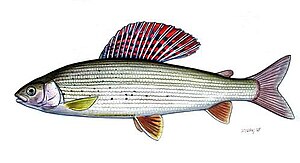European grayling
| European grayling | ||||||||||||
|---|---|---|---|---|---|---|---|---|---|---|---|---|

European grayling |
||||||||||||
| Systematics | ||||||||||||
|
||||||||||||
| Scientific name | ||||||||||||
| Thymallus thymallus | ||||||||||||
| ( Linnaeus , 1758) |
The European grayling ( Thymallus thymallus ) is a freshwater bony fish from the Salmonidae family . It was named Fish of the Year in Germany in 1997 and 2011 and in Austria in 2002 and 2011 .
features
The weight of the adult grayling is about 500 to 1500 grams; the length of the adult grayling is usually between 30 and 50 centimeters. Particularly large specimens can weigh up to 3000 grams and be up to 60 centimeters long. Noticeable features of the grayling are the pear-shaped pupils that taper towards the front, the large dorsal fin , and the conspicuous round scales that are large in relation to the body size . This dorsal fin, the so-called grayling flag, is more drawn back in the male grayling than in the female. The milkers (males) impress with it during the spawning season and lay their dorsal fin over the back of the rogner (female) during spawning . In the case of the Arctic grayling ( Thymallus arctica ), which occurs on the North American continent as far as Montana and in Northeast Asia , the rear part of the dorsal fin is even extended to the adipose fin . The grayling spawn i. d. Usually in spring (March – April), depending on the habitat also in early summer on shallow gravel banks. The larvae remain hidden between the stones until their yolk sac is used up.
habitat
The European grayling occurs from England and Wales via the (central) mountainous regions of northern, central, eastern and western Europe to the Black Sea . No natural stocks are found in the western parts of the Benelux countries , in southern France , the Iberian Peninsula , southern Italy and Greece . It is not autochthonous in most of Norway and Denmark either .
Due to water pollution and obstructions, the grayling is in decline. It needs clear, cool water and grows rather slowly. It is controversial whether the feeding pressure of the cormorant has reduced grayling populations in Europe.
On Lake Constance and the Rhine , a connection between the cormorant and grayling population was established: on the stretches of the Rhine where cormorant repulsions are regularly carried out on an experimental basis, the grayling populations have recovered comparatively strongly after the hot summer of 2003, while in the Konstanz funnel , despite the improved water quality, are continuing to decline.
However, other factors also seem to be responsible for this: While the cormorant did not appear increasingly in Germany until the early 1990s, for example the grayling stocks on the Danube near Riedlingen declined significantly ten years earlier.
use
The grayling only plays an economic role in angling . They are bred, but only for stocking purposes, because keeping them is too expensive because of their high demands on water quality. The grayling is often fished with artificial flies , as the fish like to take in food from the surface of the water. But they can also be caught on the float rod with maggots , worms or the larvae of caddis flies . The Arctic grayling is also caught with small spinning bait .
Others
The grayling was fish of the year in Germany in 1997 and 2011, in Austria fish of the year 2002 and 2011 and was voted fish of the year 2007 by the STS (Schweizerischer Tierschutz). It is an excellent food fish , the meat of which is characterized by a slightly thyme-like odor and the fat of which was previously used as grayling lard . However, this smell disappears during preparation. In contrast to brown trout, for example , grayling does not seek cover under stones when in danger, which is why it becomes easy prey for its enemies in the mostly small rivers. One of the five main fish regions of rivers is named after her, the so-called grayling region . As an endangered species, grayling is protected by the Bern Convention at European level. In the Red List of the IUCN grayling is not classified as endangered ( "least concern").
See also: Systematics of bony fish , grayling
Individual evidence
- ↑ Overview "Fish of the Year" in Germany. German Fishing Association, accessed on February 26, 2018 .
- ↑ Overview “Fish of the Year” in Austria. Austrian Board of Trustees for Fisheries and Water Protection, accessed on February 26, 2018 .
- ↑ Ueli Rippmann, Werner Müller, Martin Peter, Erich Staub: Success control of cormorants and fisheries as well as new action plan 2005. (PDF; 1.2 MB) Federal Office for the Environment, Forests and Landscape, Bern 2005 (report of the working group on cormorants and fisheries).
- ↑ Thomas Gleinser: Anna von Diesbach's Bernese 'Pharmacopoeia' in the Erlacher version of Daniel von Werdts (1658), Part II: Glossary. (Medical dissertation Würzburg), now at Königshausen & Neumann, Würzburg 1989 (= Würzburg medical-historical research , 46), p. 39.
Web links
- European grayling on Fishbase.org (English)
- Thymallus thymallus in the endangered Red List species the IUCN 2008 Posted by: J. Freyhof, M. Kottelat, 2008. Accessed on December 31 of 2008.
- European grayling: more information and photos
